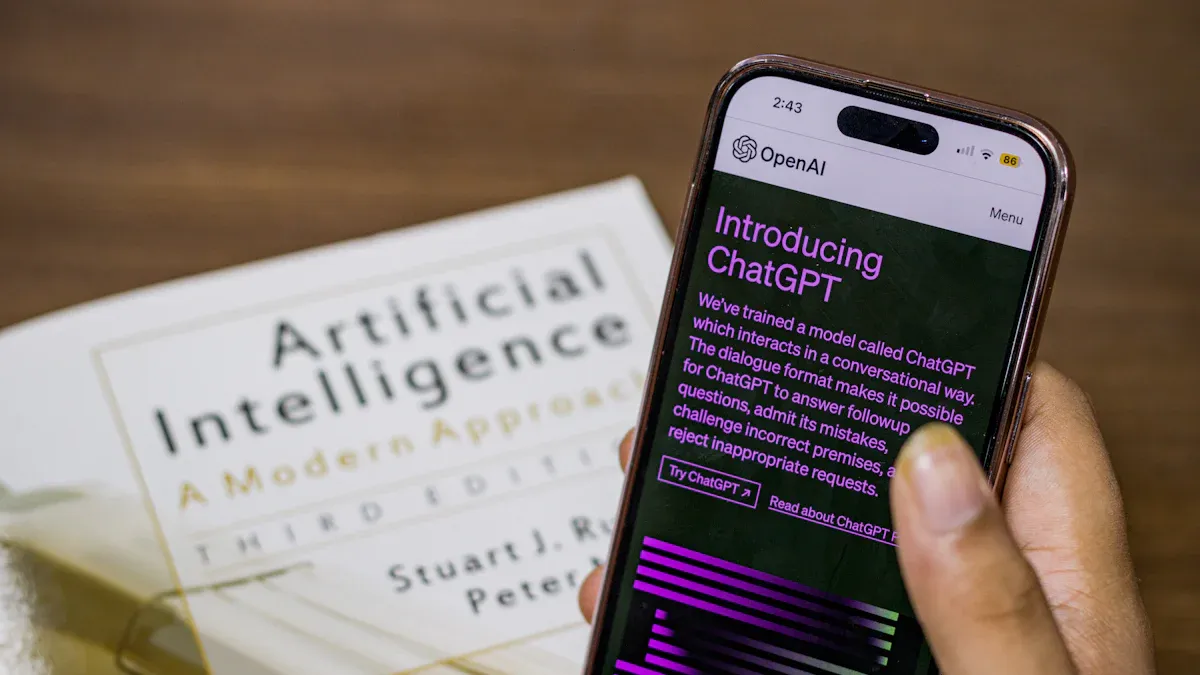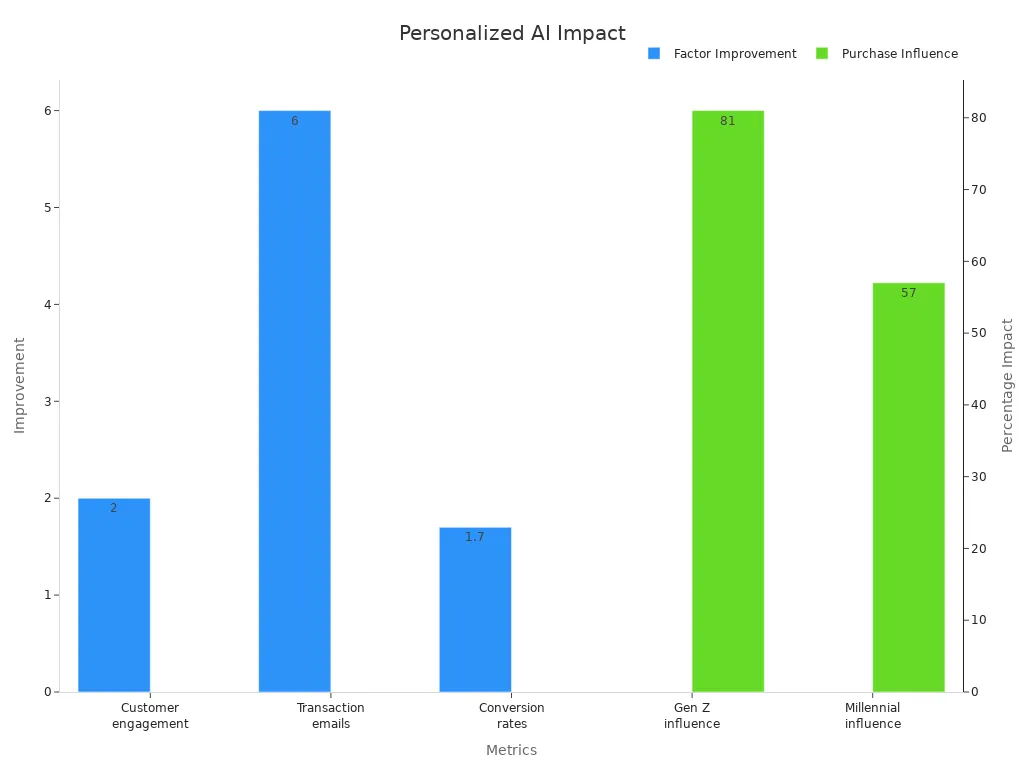How AI Identifies Viral Content Opportunities

AI identifies viral content opportunities by analyzing huge amounts of digital data, spotting hidden patterns, and predicting what might trend next. You can see its impact in numbers:
User-generated content has a stronger effect on buying decisions than marketer-created posts.
AI models predict influencer impact with high accuracy.
Automated tools mine the web for brand trends.
Research in this field gets hundreds of citations each year.
Viral content spreads quickly and reaches a wide audience, making it valuable for both creators and marketers. When you spot trends early, you gain a real advantage.
Key Takeaways
AI finds viral content by analyzing large data sets, spotting patterns, and predicting trends before they peak.
Creating viral content means using unique ideas, emotional connections, and sharing at the right time to reach more people.
Real-time monitoring and predictive analytics help you act fast and plan content that matches what your audience wants.
AI tools speed up content creation, help pick the best influencers, and personalize messages to boost engagement and sales.
Using AI responsibly means checking data quality, avoiding bias, and combining AI with your creativity for the best results.
Viral Content Basics
What Makes Content Viral
You might wonder why some posts explode online while others fade away. Viral content grabs attention, sparks emotion, and encourages people to share. When you see a funny video or a clever campaign, you want to show your friends. That’s how viral content spreads.
Many factors help content go viral:
Unique and creative ideas stand out. For example, Blendtec’s “Will it blend?” campaign reached 6 million views in just six days because it was fun and surprising.
Rewards and sharing features boost engagement. The Scrabble app in Paris gave users free Wi-Fi for sharing words, leading to thousands of shares in two weeks.
Timing matters. Angry Birds became a hit by launching at the right moment with addictive gameplay.
Emotional connection makes people care. Content that brings joy, surprise, or amazement often gets shared more.
Easy sharing and non-intrusive promotion help content spread naturally.
You can measure viral content using key metrics:
Metric | What It Means | Example/Statistical Insight |
|---|---|---|
Engagement Rates | Shares, comments, likes, saves | TikTok viral content averages 15% engagement rate |
Reach and Impressions | How many people see the content | TikTok 1M+ reach is common for viral posts |
Emotional Resonance | Strong feelings like joy or surprise | Used in virality scoring tools |
Timing Alignment | Posting at the right time | Trend alignment boosts prediction accuracy to 90% |
Video Completion Rate | Viewers who watch videos to the end | Shows content quality and engagement |
Why Spotting Opportunities Matters
Spotting viral trends early gives you a big advantage. When you catch a trend before it peaks, you can reach more people and grow your audience faster. Most marketers use social media to share content, and viral posts help you stand out in a crowded space.
Content marketing costs less than traditional ads and brings in more leads.
Short-form videos are on the rise, with 90% of marketers investing in them.
Personalized viral content can boost sales opportunities by 20%.
Sharing the right content at the right time increases your chances of going viral.
Tip: Focus on what your audience loves and watch for new trends. This approach helps you create content that people want to share, giving your brand a real boost.
How AI Identifies Trends

Data Analysis Methods
You can use AI to unlock the secrets behind viral content. AI Identifies patterns by studying huge datasets of past viral posts. It looks at what made these posts successful. For example, it checks if the post had a catchy caption, a certain video length, or a regular posting schedule. AI also benchmarks engagement metrics like impressions, reach, and engagement rates. This helps you see what works better than average content.
AI Identifies best practices by reverse engineering social media algorithms. It finds out which types of posts get more attention.
Hashtag analysis is another key method. AI scans historical data to find hashtags that perform well in your niche. It checks their volume, engagement, and competition.
Trend forecasting uses data from many platforms. This lets you spot viral moments before they peak.
AI builds frameworks based on past viral patterns. These frameworks help you tailor your content for maximum reach.
Note: When you use these methods, you can create content that matches what social media algorithms like to promote.
Real-Time Monitoring
AI Identifies new trends by watching social conversations and search data as they happen. Real-time monitoring helps you spot opportunities before others do. You can use tools that track brand mentions, keywords, and competitor activity. These tools show you when a topic starts to gain attention.
Evidence Aspect | Description | Quantitative Impact / Example |
|---|---|---|
Social Listening | Tracks brand mentions, keywords, competitor conversations in real time to identify emerging trends | Detects spikes in mentions, shares, and engagement metrics |
Sentiment Analysis | Evaluates emotional tone shifts in social posts to gauge public enthusiasm or backlash | Chick-fil-A saw a 923% rise in mentions after product change, hashtag #BringBackTheBBQ gained traction |
Influencer Engagement Data | Monitors spikes in likes, shares, comments, and cross-influencer patterns signaling trend growth | Enables early detection of emerging popularity and trend consolidation |
Hashtag and Keyword Monitoring | Reveals trending conversations and viral themes through social listening tools | Identifies rising and viral hashtags for timely action |
Case Study: Spotify Wrapped | Used social listening insights to create a viral campaign with over 60 million shares in 2023 | Demonstrates turning real-time data into viral content |
You can also use Google Trends to track sudden spikes in search volume. This shows you which topics are becoming popular. You can filter by region or audience to find local trends. Comparing search terms helps you decide where to focus your content.
Monitor spikes in likes, shares, or comments to spot new trends.
Track changes in sentiment to see if people feel more positive about a topic.
Watch for similar messages across different influencers.
Use hashtag and keyword monitoring to find trending conversations.
Analyze related queries and topics to discover what else interests your audience.
Tip: Real-time monitoring lets you act fast. You can join conversations while they are still fresh.
Predictive Analytics
AI Identifies which topics have the highest chance of going viral by using predictive analytics. These models look at past data and current trends to make forecasts. They use advanced techniques like natural language processing and survival analysis. This helps you predict what content will perform best.
Many predictive models show high accuracy. For example:
Model Type | Accuracy / Metric | Reported Values / Notes |
|---|---|---|
Decision Tree | Accuracy | |
Support Vector Machine | Sensitivity | 93.34% |
Naive Bayes | Specificity | 94.30% |
XGBoost | Overall Accuracy | 0.90 |
AI-based Predictions | Average Error | 0.73% to 2.27% over multiple forecast steps |
These numbers show that AI can predict viral potential with strong reliability. Predictive analytics also uses natural language processing to study text from social media and news. This helps you understand which topics and emotions drive sharing.
Predictive analytics lets you plan content before trends peak.
You can adjust your strategy based on what the models suggest.
AI Identifies the best times and formats for posting.
Note: Using predictive analytics gives you a competitive edge. You can create content that matches what your audience wants before others do.
AI Tools and Techniques

Popular Platforms
You have many AI-powered platforms to help you find viral content opportunities. These tools use smart features to make your work easier and faster. Here is a table showing some of the most common platforms and what they offer:
Platform | AI-Powered Features | Usage Statistics / Impact |
|---|---|---|
Coactive | AI for metadata enrichment and viral content tagging | 74% reduction in manual labeling hours (Fandom case) |
HypeAuditor | AI-driven influencer audience analysis and fraud detection | Widely used for vetting influencers |
CreatorIQ | AI for influencer matchmaking, campaign optimization, content analysis | Used for campaign optimization |
inBeat | AI to discover micro- and nano-influencers on TikTok and Instagram | Helps brands find new influencers |
Zebracat | AI-generated video content statistics across social media | 46% of influencers use AI-generated content; 78% of social media ads use AI-generated videos |
Tip: Try different platforms to see which one fits your needs best. Each tool offers unique features for content discovery and analysis.
Generative AI for Content
Generative AI helps you create content quickly and keeps your workflow smooth. Here is how it makes your job easier:
AI handles repetitive tasks, so you can focus on creative ideas.
It keeps your tone and style consistent across all posts.
The technology adapts fast to new trends and seasonal topics.
AI adds SEO best practices automatically, which helps your content get found online.
You save money because you do not need a big team to make lots of content.
Many companies use generative AI to speed up content creation. For example, some startups have cut their model-building time from months to just days. This means you can react to trends much faster.
Influencer Integration
You can boost your marketing by combining AI with influencer strategies. AI tools help you pick the right influencers and track how well your campaigns work. Studies show that using AI with influencer marketing increases brand awareness and purchase intent. Data-driven influencer campaigns also build trust and loyalty with your audience.
Note: When you use AI to guide your influencer choices, you make smarter decisions and get better results. This approach helps you grow your brand and connect with more people.
Applying AI Insights
Ideation and Angles
You can use AI to break through creative blocks and spark new ideas. Generative AI tools act like digital brainstorming partners. They suggest fresh perspectives, unique hooks, and even help you structure your stories. According to a recent Adobe survey, 62% of creative professionals save almost a full workday each week by using AI, and 66% see better content quality. Tools like the Associative Creativity Sparker help you overcome mental barriers by offering unexpected word associations, which leads to more original ideas. Writers and musicians use AI to explore new directions, experiment with styles, and quickly generate variations. You get more time to refine your work and less time stuck on what to create next.
AI analyzes large datasets to spot trends and audience interests.
Predictive analytics help you forecast which topics will become popular.
Real-time social listening tools detect sudden spikes in conversations.
AI integrates SEO keyword trends, so your content is timely and discoverable.
Over 40% of brands now use AI to optimize their content for search engines.
AI Identifies patterns from past viral posts and suggests creative angles you might not have considered.
Personalization
AI helps you tailor content for each audience segment. It studies customer behavior, purchase history, and social media activity to predict what people want to see. Marketers use AI to create hyper-personalized campaigns, product recommendations, and even real-time chat experiences. Netflix and Amazon use AI algorithms to suggest shows or products you might like. AI-powered chatbots, like those at Sephora, answer questions and recommend products instantly. Predictive analytics and lead scoring help you target the right people with the right message.
Metric | Improvement Factor / Percentage |
|---|---|
Customer engagement rate | |
Transaction rates (personalized emails) | 6× higher |
Conversion rates | 1.7× higher |
Marketing ROI increase | 25% average increase |
Sales increase (revenue uplift) | ~20% increase |
Revenue from personalization | 40% more revenue generated |
Customer churn reduction | 28% decrease |
Customer satisfaction boost | Up to 30% increase |
Marketing cost reduction | 37% decrease |
Customer acquisition cost reduction | Up to 50% reduction |

Personalization powered by AI leads to higher engagement, more sales, and happier customers.
Timing and Distribution
AI helps you find the best times to post and share your content. It looks at user behavior, past engagement, and audience activity to recommend when your followers are most active. You can use tools like YouTube Studio or Facebook Insights to see heatmaps of peak times. AI-driven recommendations can boost engagement by up to 63%. You should schedule your posts during these windows to maximize reach.
Aspect | Explanation |
|---|---|
Historical Performance Analysis | AI reviews past engagement to find peak times. |
Audience Behavior Study | AI detects when your followers are most active. |
Pattern Recognition | Algorithms spot trends and adapt as behavior changes. |
Personalized Recommendations | AI gives custom posting windows for your audience. |
Engagement Prediction | AI forecasts engagement for different times. |
Audience Activity Visualization | Heatmaps show when your audience is online. |
Time Zone Optimization | AI adjusts posting times for global reach. |
Real User Impact | Creators see engagement rise by 47% to 63% after using AI timing tips. |
AI agents combine data from websites, social media, and email to give you a full view of performance.
Pattern recognition finds trends and underperformance in real time.
Automation lets you focus on strategy, not just numbers.
Continuous learning means AI adapts as your audience changes.
Smart timing and distribution help your content reach more people and drive better results.
Challenges and Best Practices
Common Pitfalls
You may find that AI-driven content strategies come with challenges. AI models can make mistakes if you do not use the right data. Sometimes, these mistakes can be serious. For example:
A healthcare algorithm once referred fewer Black patients for care because it used healthcare costs as a measure, not actual health needs.
Some models learn biases from zip codes or other data, leading to unfair results.
Datasets may lack diversity or have poor labels, which limits how well AI works for everyone.
AI can pick up on the wrong signals, like learning to spot the hospital where a photo was taken instead of the disease in the image.
Teams without enough diversity may miss hidden biases in their models.
You should also watch out for these issues:
Training AI on data from only one group can lead to unfair predictions.
Small datasets can make AI perform well in tests but fail in real life.
Errors or missing data can lower the quality of your results.
Ignoring important context, like season or marketing events, can mislead your AI.
Not following privacy rules can hurt your reputation and lead to fines.
Relying only on old data can make you miss new trends.
Always check your data and review your AI’s results to avoid these common pitfalls.
Ethical Use
You have a responsibility to use AI in a fair and honest way. Make sure your data includes different groups of people. Protect user privacy and follow laws like GDPR. Be open about how you use AI in your content. Diverse teams help spot and fix hidden biases. You should always ask if your AI could harm or exclude anyone.
Maximizing Effectiveness
You can get the best results from AI by following proven methods. AI helps you personalize content, suggest new ideas, and keep your brand voice steady. When you combine AI with your own creativity, your content stands out. AI tools also help you find the best keywords and improve your SEO.
Benchmark / Metric | Performance Improvement / Insight |
|---|---|
Blog output increase | |
Site traffic increase | 40% more visitors to your website |
Ad click-through rate | 450% higher ad engagement |
Email campaign metrics | 14% to 24% better open and click rates |
Balance AI automation with your own ideas. Keep learning about new AI trends to stay ahead. High-quality data and ethical choices will help you build trust and reach more people.
AI Identifies viral content opportunities by analyzing trends, predicting what will engage your audience, and tracking performance in real time. You can use these insights to create more relevant and timely posts. Try different AI tools to boost your efficiency and personalize your strategy. As AI advances, you will see even more ways to combine automation with your creativity. This approach helps you stay ahead as content marketing continues to evolve.
FAQ
How does AI know which content will go viral?
AI studies past viral posts and looks for patterns. It checks things like keywords, timing, and engagement. You get predictions based on what worked before. This helps you spot trends early.
Can AI help me create content faster?
Yes! AI tools can suggest ideas, write drafts, and even design images. You save time and focus on your message. Many creators use AI to speed up their work.
Is AI good for small businesses or just big brands?
AI works for everyone. Small businesses use AI to find trends, plan posts, and reach more people. You do not need a big budget to start using AI tools.
What are the risks of using AI for content?
AI can make mistakes if it uses bad data. You should always check the results. Sometimes, AI may miss new trends or show bias. Stay alert and review your content.
Which AI tools are best for finding viral trends?
Popular tools include HypeAuditor, CreatorIQ, and Google Trends.
You can try different platforms to see which one fits your needs. Each tool offers unique features for trend discovery.
See Also
Mastering Content Competition To Surpass Your Industry Rivals
Transforming Blogging With AI Tools That Redefine Success
Exploring Key B2B Content Marketing Trends For 2024
Writesonic AI And QuickCreator Face Off In Content Creation
Five Effective Strategies To Boost Healthcare Content Marketing

